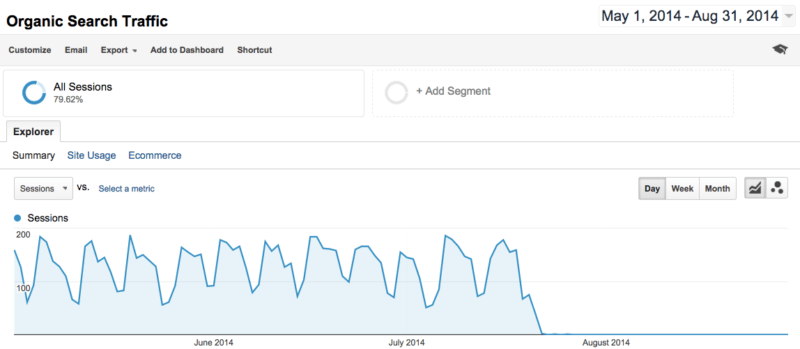This Small Business Redesigned Its Website & You Won’t Believe What Horrible SEO Thing Happened Next
Columnist Andrew Shotland took on a client who'd lost rankings as a result of a site redesign. Here's what he did to help them recover.

Redesigning websites while maintaining their SEO is akin to diamond cutting. One wrong move and you could lose all your organic traffic, not to mention your job.
But in these days of Google penalties, thin content warnings, manual spam actions, UGC spam warnings, etc., it’s often tempting to take a site that has been hit hard, toss it in the garbage and start over again.
The challenge is that if you don’t think through the SEO issues, you are more than likely going to speed up your race to the bottom.
If your site has lost a lot of organic rankings and you are about to change it dramatically, you and the rest of your team may want to read this first.
Do you still have any organic traffic? If so, is that traffic of any value?
While your site may not be generating organic leads the way it used to pre-penalty, it still may be bringing in meaningful business. Before you redo the site, you should understand that you are putting that remaining business at risk if you do not take it into account before you start the redesign.
I was prompted to write this because we recently took on a multi-location lawyer client that had relaunched its site without understanding the SEO implications. Earlier in the year, its old site had lost about 80% of its organic leads.
The site had thousands of “SEO” pages that were basically spun <insert City + Keyword here> “articles.” The strategy worked well for a year as they kept adding pages and getting more traffic. Until one day it didn’t.
The decision-makers (the web developer and the guy at the firm who was in charge of online marketing but had another day job) had read enough “expert” posts about how to recover from Google penalties to be dangerous, and they were.
The site was relaunched with a much smaller footprint and woke up the next day to find that it had lost almost all of its remaining organic lead volume. Law offices are generally quiet places. They get really quiet when the phone no longer rings.
So Why Did This Happen?
When you redo a site, three primary SEO elements get affected:
1. The Internal Links
The way you link to a page from other pages on the site impacts its ability to rank well. A simple way to think about it is that if a page has a lot of internal links, it is likely a more important page and so it probably will rank better, all other things being equal, than a page that has fewer internal links.
If your redesign reduces the number of internal links to a page, that page may drop in the rankings. In the case of our lawyer site, pretty much every page lost internal links, with unfortunate results.
2. The Content Of The Pages
If a page has the word “blue” on it and it ranks for “blue,” then if you change “blue” to “red,” there’s a good chance that you will lose your rankings for “blue.” When a page gets redesigned, the content often gets rewritten without regard to the phrases it previously was ranking for.
You may be the F. Scott Fitzgerald of Mesothelioma Attorney landing pages, but if your lead form falls in the forest with no one around, does it make a sound? (There’s a good metaphor in there somewhere, I think.)
In the case of our intrepid attorneys, they rewrote every page without really taking the terms they still ranked for into consideration.
3. The “SEO DNA”
The first two elements deal with what happens when you change a page, but what about when you delete a page? With Panda issues, it’s tempting to nuke every page that you think is causing problems.
Many gurus imply that getting rid of thin content is the key to post-Panda nirvana. In fact, I seem to recall Google’s own Amit Singhal once saying in an interview that many sites rarely cut enough to recover. (Anyone got a link to that reference?)
We have had success curing sites with millions of URLs and sites with ten URLs of Panda issues, and it often involves reworking content, noindexing, blocking URLs in robots.txt, and other tactics that make execs’ eyes glaze over. But the nuclear option is a blunt instrument, and deleting a page means deleting internal links, deleting all of the content, and fundamentally changing the “SEO DNA” of the site.
In the case of Dr. Strangelove & Partners, attorneys at law, they 404’d 99% of their site’s URLs — subsequently, all of their leads 410’d. (The 410 error indicates a page is Gone!)
So What Can You Do If This Happens To You?
In the case of our client, we were faced with two choices:
1. Try To Work With The New Site To Recover Rankings
This would be a slow, expensive process as we would have to first research which old URLs were getting traffic for what keywords, come up with a strategy to add new pages to the site — basically re-architect the site — write a lot of new copy, figure out an effective plan to 301 redirect the old URLs that were no longer in use to relevant new URLs, and implement an off-page strategy.
Hard to say what the recovery time would be, but I wouldn’t be surprised if it took at least 3-6 months. Considering the site had already been dead in the water for three months, it’s safe to say that the client would probably not love this strategy.
2. Rollback The Old Site
Sometimes you don’t realize what you’ve got till it’s gone, but if you pave a relative lead-generating paradise to put up a parking lot, you can often roll back the changes and see a fast recovery.
It doesn’t work all the time, particularly if a lot of time has passed and the old site’s 404’d URLs have been recrawled often enough by Google that whatever juice they had left has faded. Luckily, the good news about having a SMB site is that Google probably doesn’t crawl it all that often.
Thankfully, the old lawyer site was still sitting on someone’s hard drive, and with a little pride-swallowing, we convinced them to put it back up. And here’s what that looked like:
Within a week, the phones were ringing again. Within three weeks, the site had hit its highest organic traffic in 6 months.
Sure it hadn’t recovered to its previous heights, and it was still vulnerable to the issues that had been killing it before the relaunch, but at least Florrick, Agos & Associates was back in business and we could start the work of fixing the old site in a less-risky way — improving the content, strategically removing or redirecting problematic pages, and investing in outreach to market the business.
So if you think you’ve been hit with a Google penalty and someone is telling you the site needs to be totally redone, I am not saying don’t do it. I am saying make sure you know what you are doing before you do it, as the nuclear option can often lead to a nuclear winter.
If you want more tips on how to do this stuff check out my old post on how to redesign your site while still preserving your SEO. It’s still valid.
Contributing authors are invited to create content for Search Engine Land and are chosen for their expertise and contribution to the search community. Our contributors work under the oversight of the editorial staff and contributions are checked for quality and relevance to our readers. The opinions they express are their own.
Related stories
New on Search Engine Land

